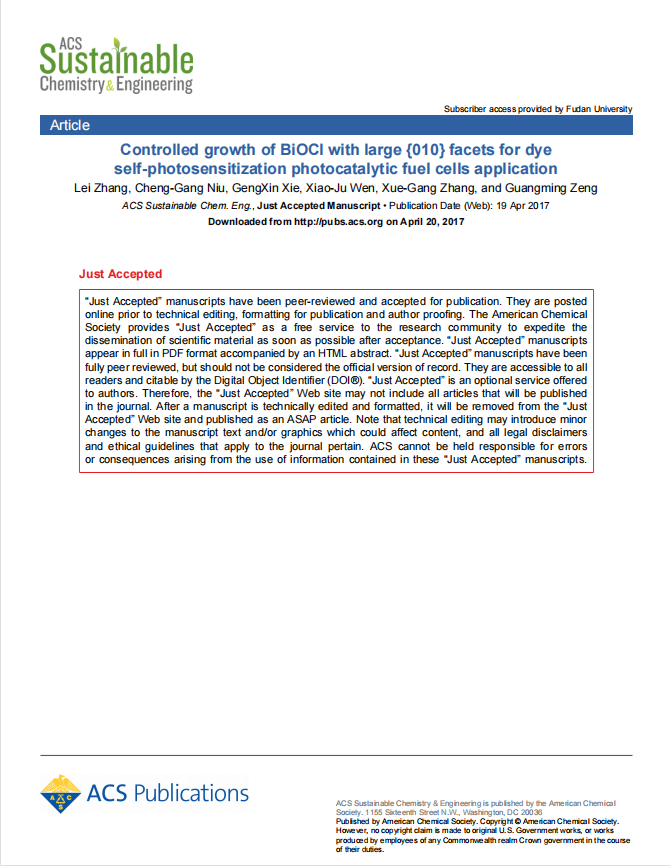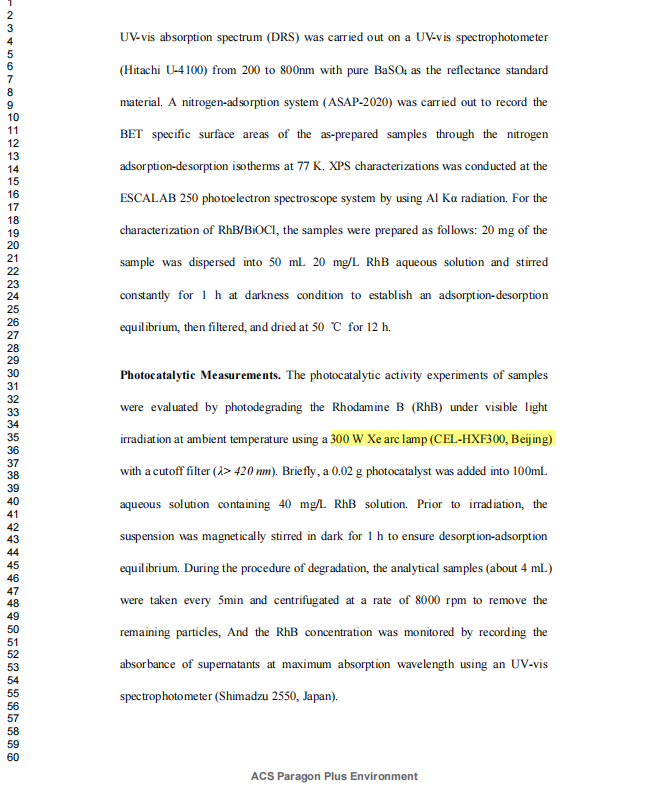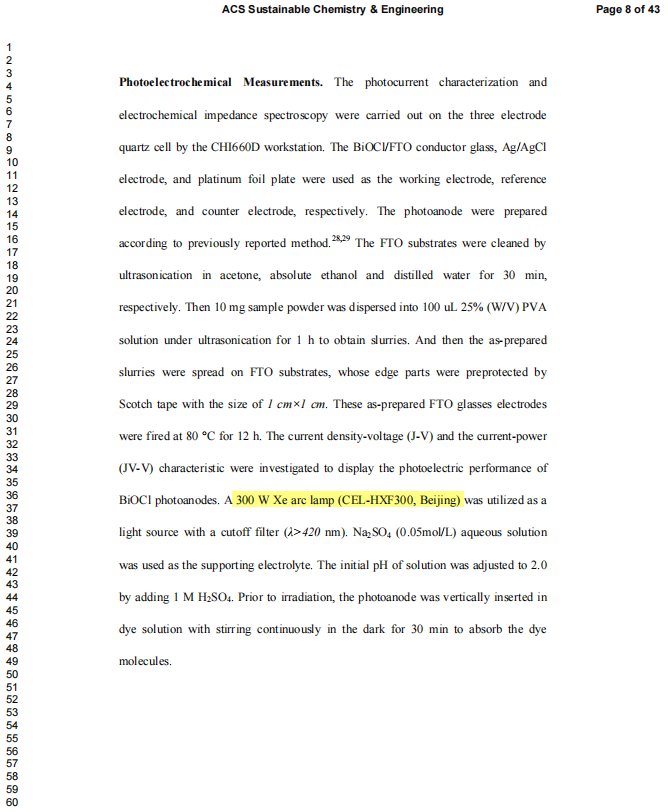Service hotline
+86 18518316054
 Current location : Home page > Resources > Papers > Controlled Growth of BiOCl with Large {010} Facets for Dye Self- Photosensitization Photocatalytic Fuel Cells Application
Current location : Home page > Resources > Papers > Controlled Growth of BiOCl with Large {010} Facets for Dye Self- Photosensitization Photocatalytic Fuel Cells Application
Abstract:
The BiOCl with {010} facets could be promising materials for photodegradation and energy conversion devices such as dye self-photosensitization photocatalytic fuel cells (DSPFCs). However, the {010} facets usually diminish rapidly during the growth process as the result of its high surface energies. In this work, we reported a simple and efficient method to prepare BiOCl with tunable exposed {010} facets. It was found that the solvent used in synthesis process acted an important roles on the formation of ultrathin construction and the growth of {010} facets by controlling the [H+ ]. For decreasing the surface energy and promoting the growth of high-active {010} facets, the thickness of BiOCl and the areas of {001} were reduced in its forming process. We had demonstrated that the enhancement of visible light-harvesting and photosensitization activity of BiOCl was primarily attributed to the decrease of thickness and the growth of {010} facets which could provide large surface areas and more active sites for dye absorption and photoelectrons transfer. The BiOCl with tunable exposed {010} areas were evaluated as photoanode materials in DSPFCs. As expected, owing to its strong dye absorption capability and high transfer efficiency of charge carriers, the DSPFC with optimal performance was obtained by employing RhB as fuel when BiOCl possessed the larger areas of {010} facets and became a thinner nanosheet structure. And the Jsc and Voc of DSPFC were measured to be 0.0058mA/cm2 and 0.689V respectively. Meanwhile approximately 67% color removal was achieved on BiOCl{010}-Pt cell by treating 40mL of 5mg/L RhB under visible light for 240min, which was much higher than P25-Pt (4%).
INTRODUCTION
The environmental pollution and excessive energy consumption have been caused great attention worldwide. Since the discovery of photocatalytically splitting of water into hydrogen over TiO2 semiconductor materials under UV light,1 the photo fuel cells (PFCs) have been demonstrated as a promising and potential technique for addressing and relieving the intense pressure between environment and energy.2-5 In PFCs system, the photoanode utilize solar energy as impetus and contaminant as fuel to simultaneously achieve the energy conversion and pollutants degradation.6 Currently, the research of PFCs devices assembled with TiO2 semiconductor materials achieved impressive achievement under UV, 3,7-8 but the limited visible light-harvesting and the presence of surface state seriously impede their wide application.9,10 Although the quantum dot, such as CdS, PbS, can be employed to enhance the visible light absorption capacity and photoelectrons transfer efficiency,11,12 the toxicity of quantum dot13 and the instability of CdS14 are of application concern.
The dye self-photosensitization photocatalytic fuel cells (DSPFCs) are developed to fulfill the high visible light-harvesting and effective photosensitization degradation.15,16 Compared to PFCs, the generation of photoelectrons came from excited dye molecules usually is much easier owing to the wide light absorption region of dye molecules.17 Moreover, the loss of photoelectrons is few and the
recombination rate of charge carriers is low in DSPFCs, because the valence band of the semiconductor is not involved in the process of photosensitization reaction.18,19 BiOCl can be used as novel promising material for DSPFCs application owing to its unique electronic structure and surface properties. Although the BiOCl cannot be photo-excited directly under visible light because of its wide band gap, it was demonstrated that the BiOCl with {010} facets exhibited excellent dye self-photosensitization performance. On the one hand, the BiOCl layered structure consisting of [Bi2O2] 2+ layers sandwiched between two slabs of halogen ions can induce the formation of internal static electric fields and endow it with open channel feature, which are beneficial for the photoelectrons transfer.20 Moreover, the conduction band of BiOCl (-1.1 eV)21,22 is more negative than TiO2 (-0.29 eV),23 therefore the formation of O2· - active species (E (O2/O2·-) (-0.046 eV))24 on BiOCl is much easier. The O2· - active species possess high oxidation activity for further pollutant decomposition. On the other hand, the BiOCl with dominant {010} facets has excellent dye absorption capacity and photosensitization performance due to its large surface areas and more surface active sites, which are favorable for enhancing the light-harvesting.18 The dye absorption capability and mobility of charge carriers are the two major impact factors on DSPFCs performance. Therefore, the controlled synthesis of BiOCl with high percentage of {010} facets has important meaning for obtaining high-performance DSPFCs. Unfortunately, the high active facets usually diminish rapidly during the growth process as the result of their high surface energies.25 26
In this study, a series of BiOCl with tunable exposed {010} facets were synthesized by a facile strategy. The impacts of solvent used in synthesis process on nanostructure of BiOCl and the growth of {010} facets were discussed in detail. The experiments of photodegradation Rhodamine B contaminant were carried out to assess the photosensitization performance of as-prepared BiOCl and investigate the relationship between {010} facets and photocatalytic activity. Moreover, the photovoltaic performances of DSPFCs assembled with BiOCl photoanodes were researched by employing RhB as fuel. Owing to the strong dye absorption capability and high photoelectrons transfer efficiency of {010} facets, the BiOCl with largest {010} facets exhibited superior photovoltaic and RhB decomposition performance than P25 and BiOCl{001}. Our work expects to open a new avenue for the wide application of BiOCl in environment protection and energy, and provide new ideas on exploitation and synthesis of photoanodes materials for high-performance DSPFCs.
EXPERIMENTAL SECTION
Photocatalytic Measurements. The photocatalytic activity experiments of samples were evaluated by photodegrading the Rhodamine B (RhB) under visible light irradiation at ambient temperature using a 300 W Xe arc lamp (CEL-HXF300, Beijing) with a cutoff filter (λ> 420 nm). Briefly, a 0.02 g photocatalyst was added into 100mL aqueous solution containing 40 mg/L RhB solution. Prior to irradiation, the suspension was magnetically stirred in dark for 1 h to ensure desorption-adsorption equilibrium. During the procedure of degradation, the analytical samples (about 4 mL) were taken every 5min and centrifugated at a rate of 8000 rpm to remove the remaining particles, And the RhB concentration was monitored by recording the absorbance of supernatants at maximum absorption wavelength using an UV-vis spectrophotometer (Shimadzu 2550, Japan).



RESULTS AND DISCUSSION
The characterization of XRD patterns was carried out to describe the crystal structure of samples. From the Figure 1.a, all of the diffraction patterns were corresponded to the BiOCl tetragonal crystals (JCPDS no.06-0249), and no other diffraction peaks were observed. However, the samples prepared in different solvent exhibited distinct differences of diffraction peaks intensity on {001} and {010} facets. Compared to the other solvent, the sample obtained in HNO3/ethanol possessed highest (001) peaks which was the characteristic diffraction peaks of {001} facets. Because the hydrogen ions in solution preferred to absorb on oxygen terminated {001} facets, therefore the BiOCl with {001} facets was easily formed under high [H+ ] condition.18 Once the [H+ ] in solution was controlled by using different solvent, the intensity of (001) peaks became weak gradually, indicating the growth rate of BiOCl was decayed along the {001} facets direction.30 Furthermore, the (110) peaks, that as characteristic diffraction peaks of {010} facets, grew rapidly. For reducing the surface energy and promoting the growth of high active {010} facets, the thickness of BiOCl became thin and the areas of {001} also decreased. As clearly showed in Figure 1.b, it could be seen that the specific values of the I(110)/I(001) gradually increased with the decrease of {001}. These results suggested that the crystal growth speed was inhibited along the {001} facets and increased along the {010} facets as the result of preferred orientation under the low [H+ ]. Different surface properties endow semiconductors with distinctive optical and electronic properties.31,32 The BiOCl with exposing large percentage area of {010} facets exhibited superior dye photosensitization activity under visible light.18,19
The typical scanning electron microscopy (SEM) images of BiOCl samples were shown in Figure 2. With the growth of {010} faces, the size of BiOCl samples gradually decreased, and the nanostructures changed from the 2D nanosheet to the 3D nanoflower (Figure 2.a~e). This change was ascribed to the change of [H+ ] in ethanol solution. All detailed parameters are displayed in Table 1. During the growth of BiOCl, the hydrogen ions in solution preferred to absorb on oxygen terminated {001} facets and increased the crystal growth speed along the ab plane. Therefore, the uniform square-shaped BiOCl nanosheets with exposing {001} were obtained in HNO3/ethanol solution. Once H2O was used as solvent, the hydrogen ions mainly came from the hydrolysis of Bi(NO3)3 and therefore the [H+ ] was much lower than HNO3 solution which resulted in the slow crystal growth speed along the ab plane. It was clearly observed that the morphology of BiOCl changed from uniform nanosheet to nanodiscs. And the BiOCl nanodiscs were much thinner and smaller than nanosheet (Figure 2.b). Compared to the H2O/ethanol, the size and thickness of BiOCl prepared in CH3COOH/ethanol became slightly smaller owing to the low degree of ionization of CH3COOH. In EG/ethanol solution, Bi3+ preferred to absorb on oxygen terminated of EG molecular to form a relatively stable complex Bi2(OCH2CH2O)3. Relatively, the stronger dissolving capacity between EG and ethanol solution is beneficial for the formation and growth of BiOCl tiny nuclei. Moreover, the tiny nuclei are not easy to reunite together in ethanol solution during the growth, leading to the final products with small crystal size (Figure 2.d). These results corresponded to the literature reports.33,34 Finally, the 3D porous nanoflower structure of BiOCl was formed through the Ostwald ripening and self-assembly process.35,36 With a further decrease of [H+ ], the BiOCl ultrathin nanosheet units were formed in NH4OH/ethanol solution first owing to the growth of {010} facets, and then the ultrathin nanosheets aggregated freely into 3D porous nanoflower to reduce the surface energy (Figure 2.e). The nanoflower structure with interlaced ultrathin nanosheets can not only greatly increase the surface areas of photocatalyst, but also enhance the multi-reflection of light.37 The decrease of size and the change of structure can influence significantly on the physical and chemical of BiOCl.
More details about the crystal structure and morphology of BiOCl were obtained from the transmission electron microscopy (TEM) images. The square-shaped BiOCl nanosheet structure was acquired in HNO3/ethanol, whose diameter and thickness were 3µm and 0.25µm (Figure 3.a). A clear lattice spacing of 0.275nm and the interfacial angle of 90。were observed (Figure 3.b), which were corresponded to the (110) lattice planes. When the [H+ ] was controlled, the size of BiOCl became small and the morphology changed to nanodiscs. The thickness of samples were estimated to be 61.5nm, 50.6nm, and 27.5nm by using H2O, CH3COOH, (CH2OH)2 as solvent, respectively (Figure 3.c~e). And the nanoflower structure of BiOCl was presented in Figure 3.f. It was clearly observed that the BiOCl nanoflower was composed of a large amount of interlaced ultrathin nanosheets with 15nm in thickness. As aforementioned, the solvent have a significant effect on the morphology and thickness of BiOCl samples. The surface areas of BiOCl can be enlarged greatly owing to the reduction of nano-sized and the formation of nanoflower structure, which can provide larger space for dye molecule absorption and chemical reaction. Moreover, the predominant defect on the surface of BiOCl would be changed from VBi ‴ to VBi ‴VO ••VBi ‴ with the decrease of thickness. The negatively charged VBi ‴VO ••VBi ‴ preferred to absorb cationic dye molecular.38 A clear and continuous lattice fringes with the lattice spacing of 0.37nm was determined by high-resolution TEM (HRTEM) image (Figure 3.g), that was corresponding to the {002} atomic planes. The physical and chemical performance of semiconductor materials is closely related with its surface properties and geometric structure.
The XPS characterization was carried out to record the surface chemical properties and composition of as-prepared BiOCl. As shown in Figure 4.a, bismuth, oxygen and chloride elements were included in the sample. The elements molar ratio was estimated to be 1:1.42:0.93 corresponding with the stoichiometric molar ratio in BiOCl. The peaks of binding energies for Bi(4f) core level were located in 164.78 and 159.48eV, which were belonged to Bi (4f5/2) and Bi (4f7/2) respectively (Figure 4.b). And the position of characteristic peaks was the same in BiOCl-HNO3 and BiOCl-NH4OH. These results suggested that the bismuth ions in BiOCl samples were in tri-valence chemical state. The binding energies of O1s in different BiOCl samples were presented in Figure 4.c. It could be clearly seen that the O1s peak position in BiOCl-NH4OH had a slightly shifts (0.31 eV) along low binding energy orientation. This suggested that the BiOCl-NH4OH surface had more negatively charge than BiOCl-HNO3, which could be attributed to the decrease of the BiOCl thickness. With the growth of {010}, the thickness of BiOCl decreased gradually, leading to the change of predominant defects on the surface of BiOCl from VBi ‴ to VBi ‴VO ••VBi ‴ . The negatively charge of VBi ‴VO ••VBi ‴ defects is favorable for cationic dye absorption.38
The Nitrogen adsorption-desorption isotherm analysis were conducted to survey the special surface area of BiOCl samples. With the growth of {010} facets, the surface areas of BiOCl reduced first and then increased, which was attributed to the change of its nanostructure (Figure 5.a). The large special surface area can offer more active sites and open space for dye molecular absorption. The BiOCl prepared in NH4OH/ethanol solution possessed the largest surface area than others due to its 3D interlaced nanoflower structure. All these detailed parameters are displayed in Table 1. The RhB adsorption curves over the as-prepared samples under darkness for 60 min were showed in Figure 5.b. As light receptors and electron donor, the adsorption efficiency of photosensitizer is an important influencing factor on the generation of photoelectrons and light-harvesting. In comparison, the RhB adsorption capability of BiOCl-NH4OH is largest than others, which is primarily ascribed to its large surface area and thin nanosheet structure. Although the BiOCl prepared in HNO3 had relatively large surface area (17.302 m2g -1), the RhB adsorption capability was lowest than others, revealing that the physical performance of BiOCl was closely related with {010} facets. The {010} facets could provide more active sites for cationic RhB molecules absorption. For DSPFCs, the large special surface areas are plays a vital role on enhancing the harvest of visible light and dye absorption capability.39 The DRS was employed to analyze the optical absorption properties of the BiOCl samples as shown in Figure 6.a. Generally, the energy gap of photocatalys is directly determines its optical absorption performance.